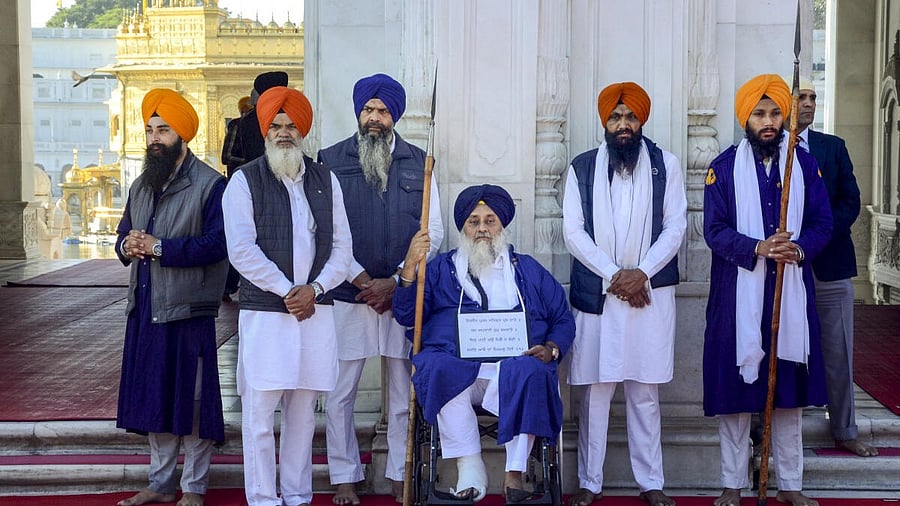
Shiromani Akali Dal leader Sukhbir Singh Badal at the Golden Temple to serve the 'tankhah' (religious punishment) given to him by the Akal Takht, in Amritsar, Wednesday, Dec. 4, 2024. Badal was later attacked by an unidentified man.
Credit: PTI Photo
Former Punjab chief minister Sukhbir Singh Badal's 10-day public penance, imposed on him by the religious authority of the Sikhs, and the attack on him during that period reflect the complexities of the state's 'Panthic' politics. The events have a direct bearing on the lurking threat of extremism.
From the perspective of India's secular polity, Badal's penance — involving menial tasks at the Golden Temple in Amritsar — may be confusing. But he is not the first ex-CM to have been punished for lapses during his tenure; dozens of political leaders have faced similar actions.
Why would Badal undergo religious punishment for actions taken in a secular capacity? And why would a fanatic attempt to assassinate him even as he atoned for those 'sins'?
Understanding the Akal Takht's role in administering 'justice' to politicians calls for an understanding of the Sikh doctrine of miri-piri, that is, the interconnection between the worldly and the spiritual. This fundamental principle does not represent a separation of politics and religion, so much as a harmonious balance between the two.
It has shaped the Sikh psyche ever since Guru Hargobind Singh (1595-1644). As historian Tarlochan Singh pointed out, "all major Sikh political movements have been anchored to the Sikh doctrine of miri-piri".
The Golden Temple is a material representation of this principle. The Akal Takht (temporal authority) faces the Harmandir Sahib (spiritual authority), but is placed at a slight angle, signifying the ascendancy of the latter. An over-emphasis on politics creates an imbalance of miri-piri, and calls for intervention.
The Akal Takht leads the Sikh community worldwide and steps in during times of crisis, religious or political. Such as the factional feud that erupted in the Shiromani Akali Dal (SAD), India's oldest regional party, earlier this year.
Then comes the vexed question of why Badal, having submitted to the Akal Takht, was targeted by a radical? This, too, reflects the vagaries of Punjab's Panthic politics, which comprises the interplay of moderate, extremist and militant elements.
Crucial poll coming
Founded in 1920, the SAD sprang from the Gurdwara Reform Movement and is therefore, in spirit, a Panthic party. Its policies were centred around the interests of the Panth (community), and the Sikh identity, regionalism and cultural separateness.
The movement led to the formation of the Sikh Gurudwara Prabandhak Committee (SGPC), an elected body that represents all Sikhs. The SGPC appoints the jathedar (head) of the Akal Takht, which remains the ultimate arbiter of social behaviour and religious beliefs.
Punjab politics has for the most part been shaped by the interdependence of the SGPC, the SAD and the Akal Takht. Elections to the SGPC are thus of vital importance. For the most part, the SGPC has been dominated by SAD-backed candidates, who won a thumping majority in the last elections, held in 2011.
After a long gap, another round of elections is to be held in 2025, and the results may well be critical to the future of Punjab. With the SAD at its lowest point, and secular parties like the Congress and AAP suffering a loss of credibility, there is a real fear of extremist resurgence. The fact that two hard-right candidates won in the 2024 Lok Sabha polls is itself disturbing. One of them, Amritpal Singh, was jailed under the NSA, but won by a landslide. He is now calling for a new Panthic party to support Sikh interests. Such a party would be decidedly pro-Khalistan in outlook.
The implosion of the SAD has created space for Amritpal and his ilk. Earlier this year, rebellion in the ranks led to the resignation of Badal as SAD president. The Akal Takht declared him an apostate (tankhaiya) and held him accountable for incidents of sacrilege during his tenure.
Long wheel of history
Rebellion within the SAD is nothing new. From its very inception, the coexistence of different streams of thought led to factionalism. In the early 1960s, activist Master Tara Singh and social reformer Sant Fateh Singh parted ways. The latter gained control of the SGPC and spearheaded the formation of a separate state of Punjab in 1966. This led to the domination of the Jat Sikhs, and the subsequent personality clashes and power plays resulted in further splits.
In the turbulent 1970s, the charismatic preacher Sant Jarnail Singh Bhindranwale emerged, even as the faction-ridden SAD was held to have failed the Panth. This led to the rise of extremism and a decade of militancy.
The wheel turned and Punjab gave the Prakash Singh Badal-led SAD-BJP alliance an overwhelming victory in the 1997 Assembly elections. This was read as a mandate for moderate politics. It won again in 2007 and 2012. But the Badals — father and son — were perceived as having turned the SAD into a dynastic and corrupt regime during which drug mafias flourished, while Punjab’s economy tanked.
The attrition of the SAD is oxygen for hardliners. Witness the attempt on Badal's life, triggered by the sentiment that the Akal Takht has let him off lightly. The perpetrator was valorised by right wing groups even as the SGPC called for his excommunication.
The country can ill-afford another round of turbulence in the border state. In alleviating the sentiment of Panth khatre vich (Panth in crisis), the SAD should not take a hardline stance under pressure from extremists. Not just the SAD, but all players must sink their differences and unite to counter radicalism. Sarbat da bhala (welfare of all) lies in the path of moderation.
(Author is an independent journalist)